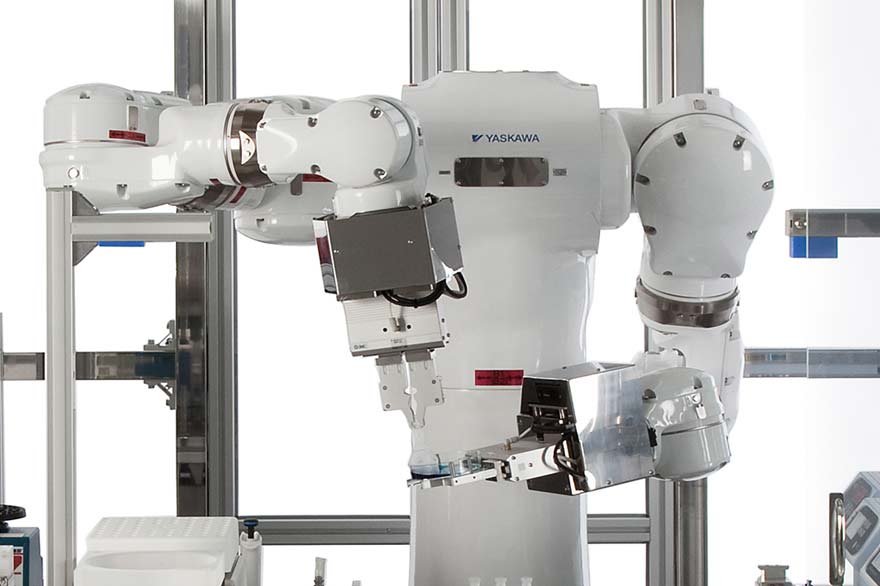With the current topics of digital transformation in production, human-robot collaboration and service robotics, robotization is intensifying, strongly contributing to the establishment of Industry 4.0 where Man bears more responsibility than ever before. The automation of economies is accelerating worldwide: the new global average for robotic density in manufacturing industries is 74 robot units per 10,000 employees (66 units in 2015). By region, the average robot density in Europe is 99 units, 84 units in the Americas and 63 units in Asia. The 10 most automated countries in the world are: South Korea, Singapore, Germany, Japan, Sweden, Denmark, the United States, Italy, Belgium and Taiwan. (1). A brief overview of the world.
« Lhe density of robots is an excellent comparison tool that allows us to take into account the different degrees of automation in the manufacturing industry in different countries", says Junji Tsuda, President of the International Robotics Federation. "Due to the high volume of robot installations in Asia in recent years, the region has the highest growth rate. Between 2010 and 2016, the average annual growth rate in robot density was 9% in Asia, 7% in the Americas and 5% in Europe. »

Asia
In China the development of robot density has been the most dynamic in the world. Due to the significant growth of robot installations, especially between 2013 and 2016, the density rate has increased from 25 units in 2013 to 68 units in 2016. Today, China is ranked 23rd in the world. And the government intends to move forward and make the country one of the top 10 most automated nations in the world by 2020. By then, its robot density should reach 150 units. In addition, the goal is to sell a total of 100,000 industrial robots produced in the country by 2020 (in 2017 27,000 units were from Chinese suppliers, 60,000 from foreign suppliers).
Globally, the Republic of Korea has by far the highest density of robots in manufacturing - a position the country has held since 2010. Robotics density is eight times higher than the world average (631 units). This rate is the result of continuous installations of a large number of robots, especially in the electrical/electronics and automotive industries.
Singapore comes second with a rate of 488 robots per 10,000 employees in 2016. About 90% of the robots are installed in the electronics industry in Singapore. Japan is in fourth place worldwide: in 2016, 303 robots were installed per 10,000 employees in the manufacturing industry, just behind Germany, which ranks third (309 units). Japan is the world's leading manufacturer of industrial robots: the production capacity of Japanese suppliers reached 153,000 units in 2016, the highest level ever recorded. Today, Japanese manufacturers supply 52% of the global supply.

Northern America
The density of robots in the United States has increased significantly to reach 189 robots in 2016 - the country ranks seventh in the world. Since 2010, the necessary modernization of domestic production facilities has boosted robot sales in the United States. The main driver of this growth was the current trend towards production automation in order to strengthen U.S. industries in the global market, to preserve domestic manufacturing and, in some cases, to repatriate manufacturing that had been relocated abroad. The main target for automation of industrial robots was the automotive industry. This accounted for about 52% of total sales in 2016. Robot sales in the United States will continue to grow between 2017 and 2020 by at least 15% on average per year.
The density of robots in Canada has been steadily increasing to reach 145 units in 2016 (13th in the world) - also mainly driven by installations in the automotive industry.
Mexico is mainly a production hub for car manufacturers and auto parts suppliers who export to the United States and increasingly to South America. The automotive industry is by far the largest customer and accounts for 81% of the market in 2016. The density of robots is 33 units, which is still well below the world average of 74 units and ranks the country 31st worldwide.

Europe
The most automated country in Europe is Germany - ranked third in the world with 309 units. The annual supply and operational stock of industrial robots in 2016 had a share of 36% and 41% per cent respectively of total robot sales in Europe. Between 2018 and 2020, the annual supply in Germany will continue to grow by at least 5% on average per year due to the increasing demand for robots in general industry and the automotive industry.
France has a robot density of 132 units (ranking 18th in the world), which is well above the world average of 74 robots - but relatively low compared to other EU countries. EU members such as Sweden (223 units), Denmark (211 units), Italy (185 units) and Spain (160 units) are much more automated with industrial robots in the manufacturing sector. But under the new government, France is in the process of regaining competitiveness in its manufacturing sectors. This may, to some extent, favour the installation of new robots in the coming years. By 2017, the number of robot installations in France is expected to have increased by about 10%. Between 2018 and 2020, an average annual growth rate between 5 and 10% is expected.

As the only G7 country - the UK has a robot density of 71 units which is below the world average of 74 units, ranking 22nd. Industry in general is in great need of the investment needed to modernise and increase productivity. The low robot density is indicative of this fact. Despite the decision to leave the EU, there are currently many announcements of investment plans to increase capacity and modernise foreign and local automotive companies. However, it is not clear whether companies will hold back investment because of the uncertain situation regarding tariffs.
Eastern European countries such as Slovenia (137 units, 16th worldwide) and Slovakia (135 units, 17th worldwide) both have a higher density of robots than Switzerland (128 units, 19th worldwide). The Czech Republic ranks 20th worldwide with 101 units. The supply of robots in the Czech Republic and Slovakia depends mainly on demand from the automotive industry. Slovenia is the most prosperous among the Balkan countries: 60% of the total supply in this region went to Slovenia (387 units, 33% more than in 2015) for the automotive industry.
(1) According to World Robot Statistics 2017, published by the International Robotics Federation. (IFR)*
* The IFR Statistics Department publishes two robotics studies each year:
- World Robotics - Industrial Robots: This unique report provides global statistics on industrial robots in standardized tables and allows national comparisons. It contains statistical data from about 40 countries divided into application sectors, industrial sectors, robot types and other technical and economic aspects. Production, export and import data are listed by country. It also describes trends in relation to robot density, e.g. the number of robots per 10,000 employees in a particular sector.
- World Robotics - Service Robots: This unique report provides global statistics on service robots, market analysis, case studies and international research strategies on service robots. The study is prepared jointly with our partner Fraunhofer IPA, Stuttgart.
To go further :
– ADVANCED MANUFACTURING MEETINGS Clermond-Ferrant - Business Convention on Innovative Technologies, Processes and Materials on May 29 - 30, 2018 - Clermont-Ferrand, France
- Salon Automatica from 19 to 22 June 2018 in Munich, the international trade fair for robotics and automation, the reference meeting place for manufacturers and users of integrated assembly, robotics, machine vision and professional service robotics solutions.
– ROBOT4MANUFACTURING - Business Convention for Industrial Robotics, October 24 - 25, 2018 - La Roche-sur-Yon, France













